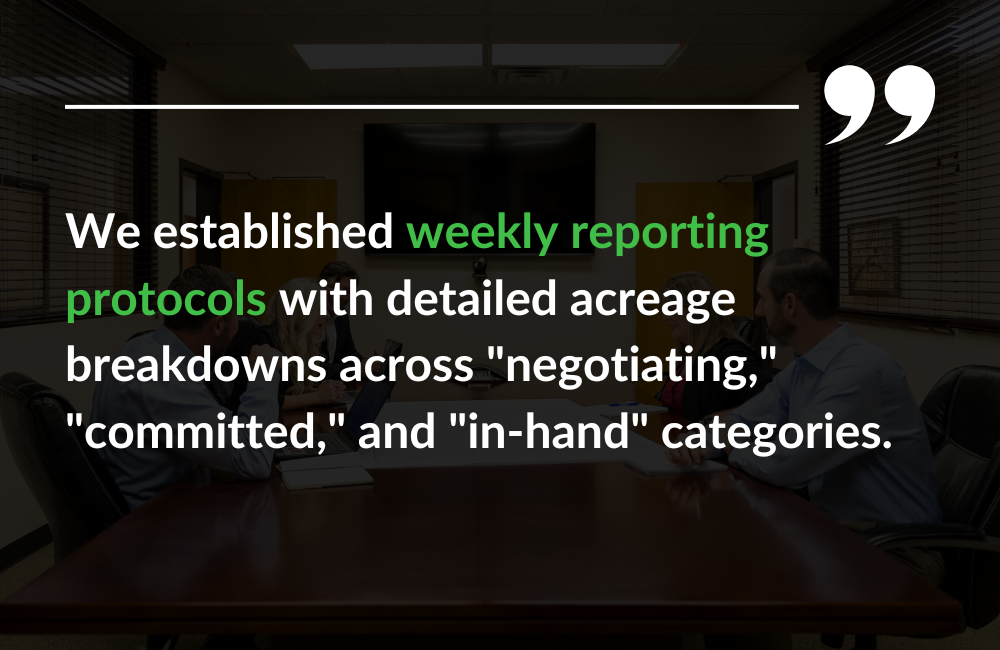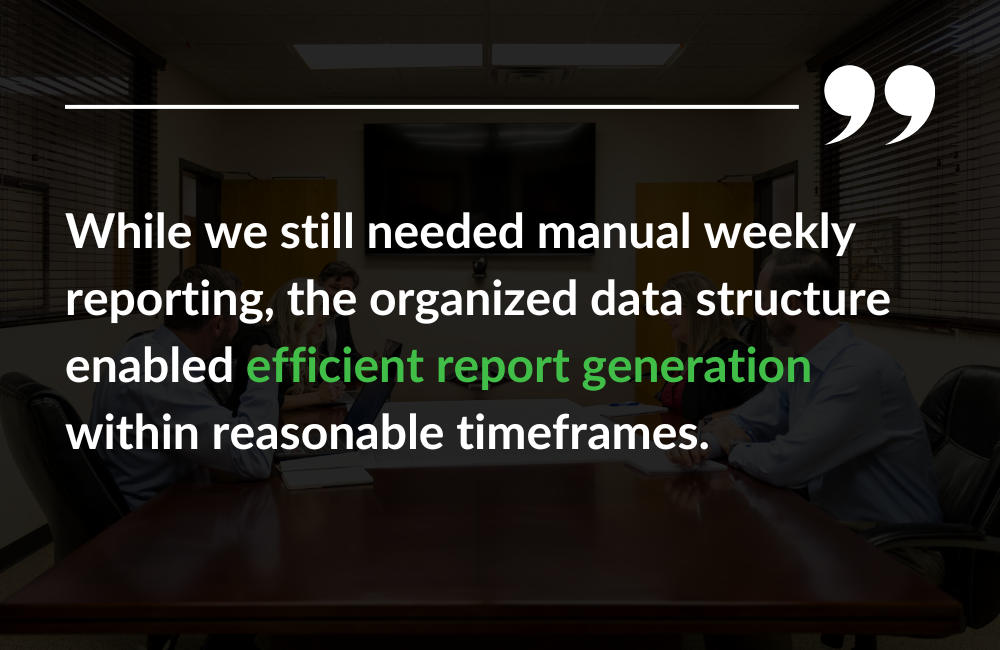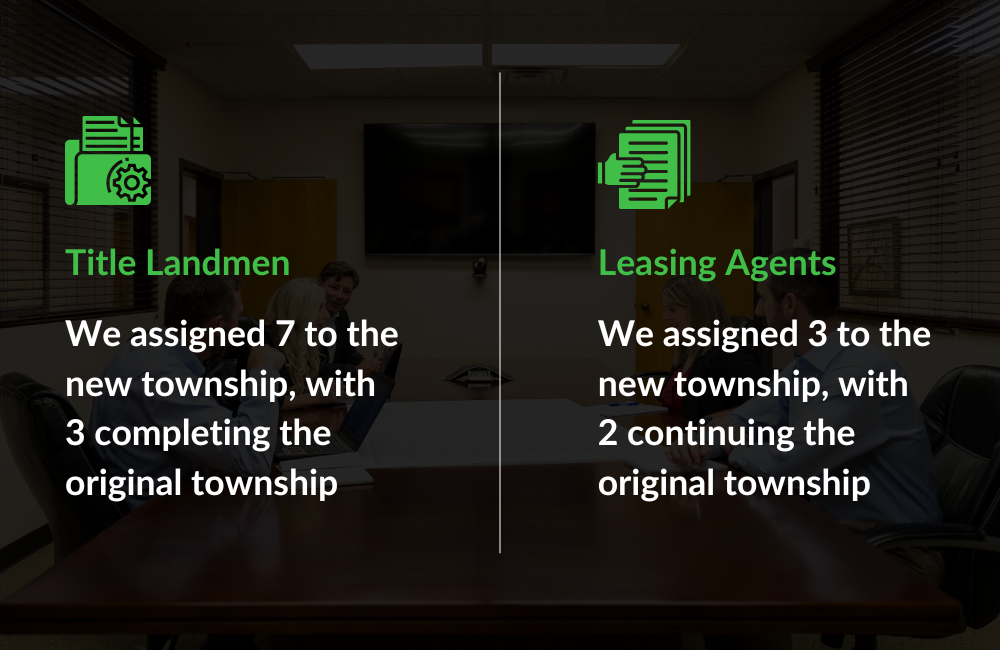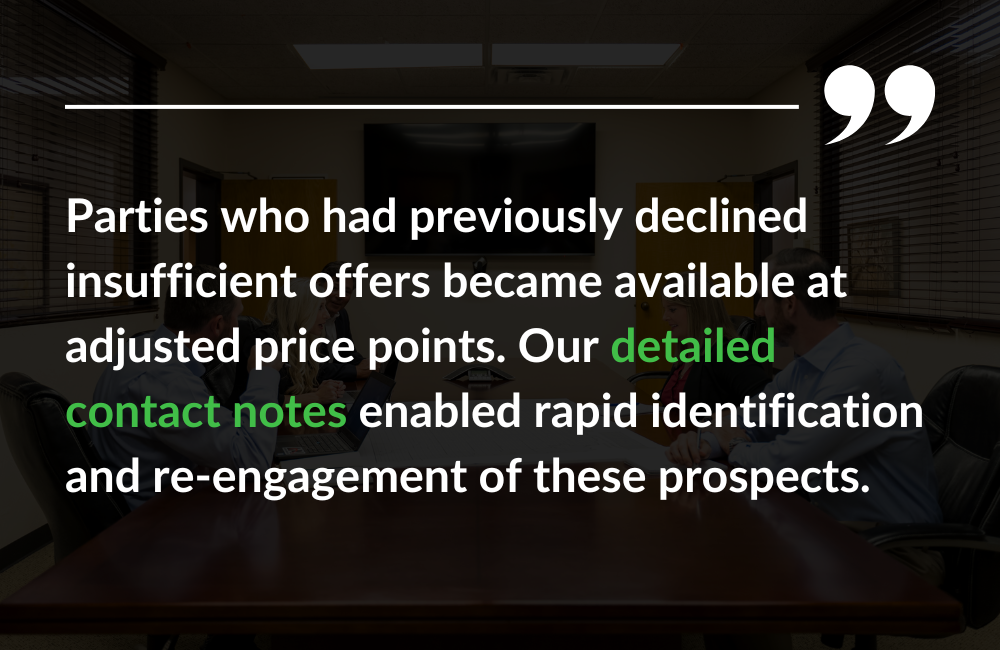
Leasing Within 65,000+ Acres in Four Months: The Pine Valley Project
Project Overview
This case study examines the Pine Valley Title and Leasing project we conducted in Oklahoma from September through December 2024. We'll walk through our execution process, challenges we encountered, solutions we implemented, and key learnings for future projects. While every project has unique circumstances, the operational insights here provide a framework for streamlining success and avoiding common problems.
The Client's Objective
Our client came to us with a clear mandate: lease as much acreage as possible in their target area of interest while staying below a specified bonus per acre. The challenge was maintaining complete project confidentiality, even within Dudley offices. To meet this requirement, we created Pine Valley Energy and registered it with the Oklahoma Secretary of State.
The competitive landscape already showed activity. Two other brokerages were working nearby townships and had each secured over 1,000 net mineral acres. This established a clear benchmark and high expectations for rapid delivery.

We established weekly reporting protocols with detailed acreage breakdowns across "negotiating," "committed," and "in-hand" categories. All parties understood that acreage values would fluctuate as title confirmation progressed throughout the project.
Project Foundation and Setup
Area Assessment and Mapping
Our initial area of interest comprised a single township requiring comprehensive assessment before team deployment. Our systematic approach included:
- Obtaining well information for the entire area
- Identifying active wells producing from the client's target formations
- Reviewing spacing orders for each active well
- Mapping lands currently held by production (HBP)
- Confirming which sections were open for leasing
Once we mapped the open sections and set them up in KUDU, we moved to team building.
Building the Right Team
The client initially requested 10 title landmen and 5 leasing agents. This is where leveraging the Dudley network proved essential. Other projects had already committed most regional landmen, and qualified leasing agents remained in limited supply.
Through coordination with mid-continent managers and our executive team, we established our operational team: 3 leasing agents and 7 title landmen. Not our target capacity, but sufficient to begin operations while continuing recruitment.
Setting Up Systems
Given the client's preference against full title examination on open sections, we implemented cursory examinations based on historical leasing patterns. We obtained and digitized courthouse indexes for all open sections, then established the project in BaseCamp with dedicated task assignments and documentation for each section.
Field Operations and Data Management
Research and Analysis
We assigned each title landman specific sections with clear directives: document all leasing activity from the previous 15 years and identify mineral owners not currently bound by primary term leases. This investigative work required thorough analysis since parties who leased in 2015 might have sold or died during the intervening years.
Landmen submitted reports containing:
- Section/township/range
- Owner name/address (from last pertinent document)
- Legal description
- Notes/comments
The Master Spreadsheet System
As section reports came in, we compiled everything into a master spreadsheet documenting all probable open owners in the area of interest. One dedicated title landman conducted cursory reviews of each identified owner to estimate net mineral acres, giving our leasing agents foundational knowledge for offer development.
The master spreadsheet became our central command, accessible to all team members and containing:
- Section/township/range
- Owner name/address
- Legal description (and KUDU ID)
- Cursory net mineral acreage
- Notes/comments
Leasing Operations
We assigned leasing agents specific sections for contact development and outreach after we completed ownership identification. We enhanced tracking by adding status columns for:
- Contact date
- Not contacted
- Negotiating
- Committed
- In-hand
- Contact notes
This system enabled us to generate the comprehensive weekly metrics our client required:
- Number of active landmen on the project
- Total number of leases (entire project)
- Total net mineral acres in-hand (entire project)
- Total net mineral acres committed (entire project)
- Total lease bonus paid (entire project)
- Plus additional detailed metrics
The Two-Spreadsheet Solution
After committing several hundred acres in the first few weeks, we created a second spreadsheet (restricted access) for title verification assignments and confirmed acreage tracking. This separated critical executed lease data from the broader master spreadsheet containing all identified owners.

We found this dual approach essential because leasing agent input inconsistencies caused errors in KUDU project summaries. While we still needed manual weekly reporting, the organized data structure enabled efficient report generation within reasonable timeframes.
Addressing Operational Challenges
Mapping Coordination
One area needing improvement was our mapping coordination process. The mapping team delivered excellent results throughout the project, but our information delivery process required refinement.
The core challenge: mapping required tract-by-tract status updates at the KUDU ID level. Weekly deliverables meant manually confirming lease status for each unique KUDU ID across both spreadsheets. This process initially took 1-2 hours weekly and grew with area of interest expansion.
Mid-Project Adaptations
Documentation Strategy Change
We initially planned to file leases of record, so we included no memorandums of oil and gas lease in initial packets. After executed leases began returning, the client shifted strategy, determining that they preferred recorded memorandums.
We coordinated with our document team to develop memorandums, though we encountered some challenges. Oklahoma requirements had configured the existing tokenized template, requiring leasing agents to make manual modifications outside standard system protocols. While these adjustments didn't create filing problems, the out-of-system changes increased error potential and created inconsistency across agents.
Regulatory Changes
Oklahoma amended recording requirements effective November 1, 2024, mid-project, requiring larger top margins than our initial memorandum template provided. This change potentially affected the dozen-plus executed memorandums we'd already received.
Rather than requiring re-execution, we contacted the local courthouse directly. They demonstrated flexibility, agreeing to file existing non-compliant memorandums without penalty while requiring future submissions to meet updated standards.
Scaling Operations
Second Township Addition
Our initial project success earned us a second township assignment. After we completed the same examination process, we expanded our team through collaboration with our recruiting team:
- 2 additional leasing agents
- 3 additional title landmen
- Additional support for lease packet compilation and client system invoicing
Management Structure Enhancement

We found increased scope and personnel necessitated adding a crew chief for project oversight. We strategically reallocated resources:
Leasing agents: We assigned 3 to the new township, with 2 continuing the original township
Title landmen: We assigned 7 to the new township, with 3 completing the original township
Bonus Structure Adjustment
As second township operations began, initial area success started plateauing. Client discussions regarding bonus structure resulted in offer increases. The client acknowledged that initial bonuses were conservative relative to budget and approved enhanced offers.

The impact was immediate. Parties who had previously declined insufficient offers became available at adjusted price points. Our detailed contact notes enabled rapid identification and re-engagement of these prospects.
Third Township Integration
Shortly after the second township assignment, the client added a third. Our established processes and systems enabled efficient integration. We balanced personnel across three concurrent operations:
- Title teams conducting interest verifications for executed leases in townships one and two
- Title teams performing cursory examinations and prospect identification in townships two and three
- Leasing agents managing new owner outreach alongside ongoing negotiations and executed lease administration
Project Conclusion
The client made the decision to terminate the project as we were assigning the third township. The client's instructions specified immediate cessation of leasing activities with formal notification protocols for affected parties.
Owner Notification Process

We established two notification categories:
- Unexecuted lease recipients: Verbal and written notification of submission deadlines with clear offer rescission dates
- Active negotiation parties: Formal letters establishing offer expiration timeframes
Leasing agents coordinated delivery while we maintained detailed mail tracking spreadsheets, giving the client complete visibility into correspondence timing and recipients.
Team Transition Management
We reassessed resource needs based on established deadlines. We notified leasing agents of project conclusion due to fixed offer expiration dates, while title landmen continued until they completed interest verification to ensure proper bonus payments.
We held individual conversations with team members that required careful consideration. These professionals had invested significant effort, faced holiday timing uncertainty, and needed clarity about future opportunities. We approached each discussion thoughtfully, considering individual circumstances rather than following standard scripts.
While contractors understand service-based engagement terms, project conclusion requires more than simple acknowledgment. Demonstrating genuine appreciation and understanding of professional uncertainty requires time investment in listening and addressing individual concerns.
Key Learnings and Future Applications
This project encompassed rapid initiation, intensive execution, strategic adjustments, and abrupt conclusion. Each phase provided valuable operational insights.

Smarter Staffing Approach
Initial staffing felt like a scramble to assemble a 10-15 person team. The primary issue was attempting independent hiring rather than fully leveraging Dudley's established network and management resources.
Engaging Dudley's management team immediately relieved staffing pressures.
Key Learning: Start with the DLC landman map, check bench availability, and collaborate with Dudley teams for resource assembly rather than independent hiring under time pressure.

Improved Organization and Workflow
The shared master spreadsheet served its purpose while creating operational challenges. One notable incident involved a leasing agent accidentally modifying all initial contact dates through copy/paste error, significantly complicating weekly reporting. Recovery required extensive manual contact notes review.
Future Approach: Maintain centralized master spreadsheet access limited to project management, while providing individual leasing agents separate spreadsheet versions for weekly submission. This reduces system-wide error risks.

Enhanced Mapping Process
Weekly map generation required similar problem-solving intensity as initial staffing, fundamentally relating to spreadsheet organization.
Improved Methodology: Implement unique owner IDs within each section for easier change identification. Use pivot tables for owner categorization by section, enabling rapid status change identification.

Data Management Standards
KUDU data input inconsistencies by leasing agents created operational issues: categorization errors, contact note problems, and unauthorized external document modifications.
Future Requirements: Establish clear data entry standards before project initiation. Maintain external change tracking spreadsheets for system integration of any out-of-system modifications.

Title Review Process Enhancement
The most effective title review system I've used was on a previous Ohio project wherein examination teams produced runsheets and ownership reports, there were dedicated review teams, and a final quality assurance before the deliverable submission.
For Similar Projects: Implement 8 title landmen conducting examinations, 1 full-time reviewer, and 1 crew chief to reduce direct review burden.
Conclusion
This project achieved successful outcomes while identifying numerous efficiency opportunities. We have already implemented these learnings in post-project operations and have demonstrated significant organizational improvements, enhancing our ability to manage multiple concurrent projects.
Key Takeaways:
- Front-end investment pays dividends - Comprehensive project setup reduces complexity for both management and contractor teams
- Robust systems enable scalability - Well-designed processes allow efficient expansion from one township to three
- Clear expectations drive success - When you know your costs upfront for both dollars and days, everyone benefits
- Systematic application of learnings - These operational insights position future projects for enhanced predictability, efficiency, and success
We can position future projects for enhanced predictability, efficiency, and success through systematic application of these operational insights.


